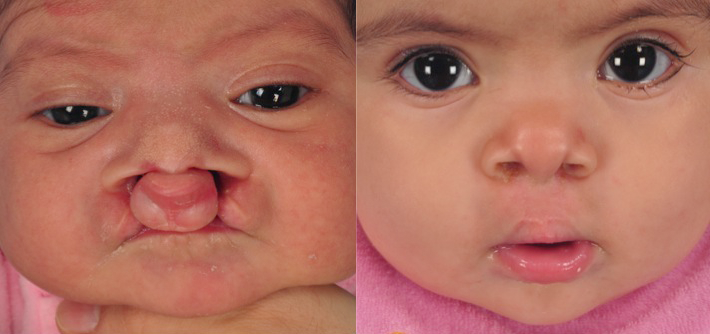Bilateral Cleft Lip
& Cleft Palate
Bilateral cleft lip affects 1 in 10 children with cleft lip and palate. In bilateral cleft lip, the two sides of the cleft may be of the same or very different severity. The major difference between unilateral and bilateral cleft lip and palate is the effect of the forward displacement of the middle portion of the lip and gums (premaxilla).
The middle portion of the lip and gums are partially or completely separate from the adjacent lip and gums. This results in significant shortening of the middle part of the lip. The forward displacement of the central lip and gums also causes severe shortening of the columella (the skin and cartilage between the nostrils) which significantly changes the appearance of the nose.
While the nose has a fairly normal appearance in the bilateral incomplete cleft lip the central lip is very short. This central lip segment does not have the normal lip muscle in it. This leads to less bulk and a shorter lip because the muscle has not been stretching this part of the lip out. The lateral lip segments are much taller than the central segment.
-
Bilateral cleft lip repair is typically performed at 3 -4 months of age. Most patients in my practice receive nasoalveolar molding (NAM) by Dr. Yongjong Park, our dedicated craniofacial orthodontist. NAM is used to help align the gums, narrow the cleft and reshape the nose. For babies with bilateral cleft lip and palate, NAM is critical to help achieve lengthening of the columella to help achieve a normal nasal appearance. NAM is complete by age 3-4 months. We also wait until age 3-4 months to allow the babies to grow so they will less physiologically challenged by the operation. The operation takes about 3-4 hours. The patients look improved immediately after the surgery. The majority of patients stay overnight in the hospital for 1 night to make sure they are drinking well before they go home. Prescribed pain medicine is typically used for 2-3 days. Some sutures are removed after 5-7 days. Scar care is discussed in detail at the time of suture removal. The figure below demonstrates typical incisions design for a cleft lip repair to hide the scars in the normal features of the lip.







